Photoluminescence and Photocatalytic Properties of MWNTs Decorated with Fe-Doped ZnO Nanoparticles
Abstract
:1. Introduction
2. Materials and Methods
2.1. Materials
2.2. Sample Preparation
2.2.1. Synthesis of ZnO:Fe Nanoparticles
2.2.2. Decoration of MWCNT with ZnO:Fe
2.3. Methods
2.4. Evaluation of Photocatalytic Activity
3. Results and Discussions
4. Conclusions
Supplementary Materials
Author Contributions
Funding
Institutional Review Board Statement
Informed Consent Statement
Data Availability Statement
Acknowledgments
Conflicts of Interest
References
- Nazir, M.A.; Najam, T.; Shahzad, K.; Wattoo, M.A.; Hussain, T.; Tufail, M.K.; Shah, S.S.A.; Rehman, A.U. Heterointerface engineering of water stable ZIF-8@ZIF-67: Adsorption of rhodamine B from water. Surf. Interfaces 2022, 34, 102324. [Google Scholar] [CrossRef]
- Tóth, A.J.; Fózer, D.; Mizsey, P.; Varbanov, P.S.; Klemeš, J.J. Physicochemical methods for process wastewater treatment: Powerful tools for circular economy in the chemical industry. Rev. Chem. Eng. 2022. [Google Scholar] [CrossRef]
- Al-Tohamy, R.; Ali, S.S.; Li, F.; Okasha, K.M.; Mahmoud, Y.A.-G.; Elsamahy, T.; Jiao, H.; Fu, Y.; Sun, J. A critical review on the treatment of dye-containing wastewater: Ecotoxicological and health concerns of textile dyes and possible remediation approaches for environmental safety. Ecotoxicol. Environ. Saf. 2022, 231, 113160–113172. [Google Scholar] [CrossRef] [PubMed]
- Nazir, M.A.; Najam, T.; Jabeen, S.; Wattoo, M.A.; Bashir, M.S.; Shah, S.S.A.; Rehman, A. Facile synthesis of Tri-metallic layered double hydroxides (NiZnAl-LDHs): Adsorption of Rhodamine-B and methyl orange from water. Inorg. Chem. Commun. 2022, 145, 110008. [Google Scholar] [CrossRef]
- Znad, H.; Abbas, K.; Hena, S.; Awual, M.R. Synthesis a novel multilamellar mesoporous TiO2/ZSM-5 for photo-catalytic degradation of methyl orange dye in aqueous media. J. Environ. Chem. Eng. 2018, 6, 218–227. [Google Scholar] [CrossRef]
- Bhowmik, M.; Deb, K.; Debnath, A.; Saha, B. Mixed phase Fe2O3/Mn3O4 magnetic nanocomposite for enhanced adsorption of methyl orange dye: Neural network modeling and response surface methodology optimization. Appl. Organomet. Chem. 2018, 32, 4186. [Google Scholar] [CrossRef]
- Sejie, F.P.; Tabbiruka, M.S.N. Removal of methyl orange (MO) from water by adsorption onto modified local clay (kaolinite). Phys. Chem. 2016, 6, 39–48. [Google Scholar]
- Eljiedi, A.A.A.; Kamari, A. Removal of methyl orange and methylene blue dyes from aqueous solution using lala clam (Orbicularia orbiculata) shell. AIP Conf. Proc. 2017, 1847, 040003. [Google Scholar] [CrossRef]
- Mate, C.J.; Mishra, S. Synthesis of borax cross-linked Jhingan gum hydrogel for remediation of Remazol Brilliant Blue R (RBBR) dye from water: Adsorption isotherm, kinetic, thermodynamic and biodegradation studies. Int. J. Biol. Macromol. 2020, 151, 677–690. [Google Scholar] [CrossRef]
- Ahmad, M.A.; Puad, N.A.A.; Bello, O.S. Kinetic, equilibrium and thermodynamic studies of synthetic dye removal using pomegranate peel activated carbon prepared by microwave-induced KOH activation. Water Resour. Ind. 2014, 6, 18–35. [Google Scholar] [CrossRef] [Green Version]
- Nafi, A.W.; Taseidifar, M. Removal of hazardous ions from aqueous solutions: Current methods, with a focus on green ion flotation. J. Environ. Manag. 2022, 319, 115666. [Google Scholar] [CrossRef] [PubMed]
- Opitz, J.; Bauer, M.; Alte, M.; Peiffer, S. Development of a novel sizing approach for passive mine water treatment systems based on ferric iron sedimentation kinetics. Water Res. 2023, 233, 119770. [Google Scholar] [CrossRef] [PubMed]
- Heebner, A.; Abbassi, B. Electrolysis catalyzed ozonation for advanced wastewater treatment. J. Water Process. Eng. 2022, 46, 102638. [Google Scholar] [CrossRef]
- Ramu, A.G.; Choi, D. Highly efficient and simultaneous catalytic reduction of multiple toxic dyes and nitrophenols waste water using highly active bimetallic PdO–NiO nanocomposite. Sci. Rep. 2021, 11, 22699. [Google Scholar] [CrossRef] [PubMed]
- Shariati, M.; Babaei, A.; Azizi, A. Synthesis of Ag2CrO4/Ag/Fe3O4/RGO nanocomposite as a suitable photocatalyst for degradation of methylene blue in aqueous media: RSM modeling, kinetic and energy consumption studies. Inorg. Chem. Commun. 2022, 145, 110004. [Google Scholar] [CrossRef]
- Wahba, M.A.; Yakout, S.M.; Khaled, R. Interface engineered efficient visible light photocatalytic activity of MWCNTs/Co doped ZnO nanocomposites: Morphological, optical, electrical and magnetic properties. Opt. Mater. 2021, 115, 111039. [Google Scholar] [CrossRef]
- Irani, E.; Amoli-Diva, M. Hybrid adsorption–photocatalysis properties of quaternary magnetoplasmonic ZnO/MWCNTs nanocomposite for applying synergistic photocatalytic removal and membrane filtration in industrial wastewater treatment. J. Photochem. Photobiol. A 2020, 391, 112359–112360. [Google Scholar] [CrossRef]
- Guo, J.; Li, Y.; Zhu, S.; Chen, Z.; Liu, Q.; Zhang, D.; Moon, W.-J.; Song, D.-M. Synthesis of WO3@Graphene composite for enhanced photocatalytic oxygen evolution from water. RSC Adv. 2011, 2, 1356–1363. [Google Scholar] [CrossRef] [Green Version]
- Bárdos, E.; Kovács, G.; Gyulavári, T.; Németh, K.; Kecsenovity, E.; Berki, P.; Baia, L.; Pap, Z.; Hernádi, K. Novel synthesis approaches for WO3-TiO2/MWCNT composite photocatalysts-problematic issues of photoactivity enhancement factors. Catal. Today 2018, 300, 28–38. [Google Scholar] [CrossRef] [Green Version]
- Jeevitha, G.; Sivaselvam, S.; Keerthana, S.; Mangalaraj, D.; Ponpandian, N. Highly effective and stable MWCNT/WO3 nanocatalyst for ammonia gas sensing, photodegradation of ciprofloxacin and peroxidase mimic activity. Chemosphere 2022, 297, 134023. [Google Scholar] [CrossRef]
- Dobaradaran, S.; Nabizadeh Nodehi, R.; Yaghmaeian, K.; Jaafari, J.; Hazrati Niari, M.; Bharti, A.K.; Agarwal, S.; Gupta, V.K.; Azari, A.; Shariatifar, N. Catalytic decomposition of 2-chlorophenol using an ultrasonic-assisted Fe3O4–TiO2@MWCNT system: Influence factors, pathway and mechanism study. J. Colloid. Interface. Sci. 2018, 512, 172–189. [Google Scholar] [CrossRef] [PubMed] [Green Version]
- Gao, P.; Huang, S.; Tao, K.; Li, Z.; Feng, L.; Liu, Y.; Zhan, L. Synthesis of adjustable {312}/{004} facet heterojunction MWCNTs/Bi5O7I photocatalyst for ofloxacin degradation: Novel insights into the charge carriers transport. J. Hazard. Mater. 2022, 437, 129374. [Google Scholar] [CrossRef] [PubMed]
- Yan, D.; Hu, H.; Gao, N.; Ye, J.; Ou, H. Fabrication of carbon nanotube functionalized MIL-101(Fe) for enhanced visible-light photocatalysis of ciprofloxacin in aqueous solution. Appl. Surf. Sci. 2019, 498, 143836. [Google Scholar] [CrossRef]
- Stefan, M.; Leostean, C.; Popa, A.; Toloman, D.; Perhaita, I.; Cadis, A.; Macavei, S.; Pana, O. Highly stable MWCNT-CoFe2O4 photocatalyst. EGA-FTIR coupling as efficient tool to illustrate the formation mechanism. J. Alloy. Compd. 2022, 928, 167188. [Google Scholar] [CrossRef]
- Tang, X.; Xue, Q.; Qi, X.; Cheng, C.; Yang, M.; Yang, T.; Chen, F.; Qiu, F.; Quan, X. DFT and experimental study on visible-light driven photocatalysis of rare-earth-doped TiO2. Vacuum 2022, 200, 110972. [Google Scholar] [CrossRef]
- Toloman, D.; Stefan, M.; Pana, O.; Rostas, A.M.; Silipas, T.D.; Pogacean, F.; Pruneanu, S.; Leostean, C.; Barbu-Tudoran, L.; Popa, A. Transition metal ions as a tool for controlling the photocatalytic activity of MWCNT-TiO2 nanocomposites. J. Alloy Compd. 2022, 921, 166095–166111. [Google Scholar] [CrossRef]
- Lemos, S.C.S.; de Lima Rezende, T.K.; Assis, M.; da Costa Romeiro, F.; Peixoto, D.A.; de Oliveira Gomes, E.; Jacobsen, G.M.; Teodoro, M.D.; Gracia, L.; Ferrari, J.L.; et al. Efficient Ni and Fe doping process in ZnO with enhanced photocatalytic activity: A theoretical and experimental investigation. Mater. Res. Bull. 2022, 152, 111849. [Google Scholar] [CrossRef]
- Lee, H.; Jang, H.S.; Kim, N.Y.; Joo, J.B. Cu-doped TiO2 hollow nanostructures for the enhanced photocatalysis under visible light conditions. J. Ind. Eng. Chem. 2021, 99, 352–363. [Google Scholar] [CrossRef]
- Feng, C.; Chen, Z.; Li, W.; Zhang, F.; Li, X.; Xu, L.; Sun, M. First-principle calculation of the electronic structures and optical properties of the metallic and nonmetallic elements-doped ZnO on the basis of photocatalysis. Phys. B: Condens. Matter 2019, 555, 53–60. [Google Scholar] [CrossRef]
- Râpă, M.; Stefan, M.; Popa, P.; Toloman, D.; Leostean, C.; Borodi, G.; Vodnar, D.; Wrona, M.; Salafranca, J.; Nerín, C.; et al. Electrospun Nanosystems Based on PHBV and ZnO for Ecological Food Packaging. Polymers 2021, 13, 2123. [Google Scholar] [CrossRef]
- Rocha, M.; Araujo, F.P.; Castro-Lopes, S.; de Lima, I.S.; Silva-Filho, E.C.; Anteveli Osajima, J.; Oliveira, C.S.; Viana, B.C.; Almeida, L.C.; Guerra, Y.; et al. Synthesis of Fe–Pr co-doped ZnO nanoparticles: Structural, optical and antibacterial properties. Ceram. Intl. 2023, 49, 2282–2295. [Google Scholar] [CrossRef]
- Dubey, P.; Sonkar, S.K.; Majumder, S.; Tripathi, K.M.; Sarkar, S. Isolation of water soluble carbon nanotubes with network structure possessing multipodal junctions and its magnetic property. RSC Adv. 2013, 3, 7306–7312. [Google Scholar] [CrossRef]
- Popa, A.; Pana, O.; Stefan, M.; Toloman, D.; Stan, M.; Leostean, C.; Suciu, R.C.; Vlad, G.; Ulinici, S.; Baisan, G.; et al. Interplay between ferromagnetism and photocatalytic activity generated by Fe3+ ions in iron doped ZnO nanoparticles grown on MWCNTs. Phys. E: Low-Dimens. Syst. Nanostructures 2020, 129, 114581–114590. [Google Scholar] [CrossRef]
- Buz, E.; Zhou, D.; Kittilstved, K.R. Air-stable n-type Fe-doped ZnO colloidal nanocrystals. J. Chem. Phys. 2019, 151, 134702–134708. [Google Scholar] [CrossRef]
- Misra, S.K.; Andronenko, S.I.; Thurber, A.; Punnoose, A.; Nalepa, A. An X-and Q-band Fe3+ EPR study of nanoparticles of magnetic semiconductor Zn1−xFexO. J. Magn. Magn. Mater. 2014, 363, 82–87. [Google Scholar] [CrossRef]
- Raita, O.; Popa, A.; Stan, M.; Suciu, R.C.; Biris, A.; Giurgiu, L.M. Effect of Fe Concentration in ZnO Powders on Ferromagnetic Resonance Spectra. Appl. Magn. Reson. 2012, 42, 499–509. [Google Scholar] [CrossRef]
- Rajan, C.P.; Abharana, N.S.; Jha, N.; Bhattacharyya, D.; John, T.T. Local Structural Studies Through EXAFS and Effect of Fe2+ or Fe3+ Existence in ZnO Nanoparticles. J. Phys. Chem. C 2021, 125, 13523–13533. [Google Scholar] [CrossRef]
- Kim, K.J.; Park, Y.R. Optical investigation of Zn1−xFexO films grown on Al2O3(0001) by radio-frequency sputtering. J. Appl. Phys. 2004, 96, 4150–4153. [Google Scholar] [CrossRef]
- Toloman, D.; Mesaros, A.; Popa, A.; Silipas, T.D.; Neamtu, S.; Katona, G. V-doped ZnO particles: Synthesis, structural, optical and photocatalytic properties. J. Mater. Sci: Mater Electron 2016, 27, 5691–5698. [Google Scholar] [CrossRef]
- Bai, S.; Guo, T.; Zhao, Y.; Sun, J.; Li, D.; Chen, A.; Liu, C.C. Sensing performance and mechanism of Fe-doped ZnO microflowers. Sens. Actuators B: Chem. 2014, 195, 657–666. [Google Scholar] [CrossRef]
- El Mel, A.-A.; Buffière, M.; Ewels, C.P.; Molina-Luna, L.; Faulques, E.; Colomer, J.-F.; Kleebe, H.-J.; Konstantinidis, S.; Snyders, R.; Bittencourt, C. Zn based nanoparticle–carbon nanotube hybrid materials: Interaction and charge transfer. Carbon 2013, 66, 442–449. [Google Scholar] [CrossRef]
- Jangir, L.K.; Kumari, Y.; Kumar, A.; Kumar, M.; Awasthi, K. Investigation of luminescence and structural properties of ZnO nanoparticles, synthesized with different precursors. Mater. Chem. Front. 2017, 1, 1413–1421. [Google Scholar] [CrossRef]
- Sagar, P.; Shishodia, P.; Mehra, R.; Okada, H.; Wakahara, A.; Yoshida, A. Photoluminescence and absorption in sol–gel-derived ZnO films. J. Lumin. 2007, 126, 800–806. [Google Scholar] [CrossRef]
- Zeng, H.; Duan, G.; Li, Y.; Yang, S.; Xu, X.; Cai, W. Blue Luminescence of ZnO Nanoparticles Based on Non-Equilibrium Processes: Defect Origins and Emission Controls. Adv. Funct. Mater. 2010, 20, 561–572. [Google Scholar] [CrossRef]
- Ghoderao, K.P.; Jamble, S.N.; Kale, R.B. Hydrothermally synthesized Cd-doped ZnO nanostructures with efficient sunlight-driven photocatalytic and antibacterial activity. J. Mater. Sci. Mater. Electron. 2019, 30, 11208–11219. [Google Scholar] [CrossRef]
- Van de Walle, C.G. Hydrogen as a Cause of Doping in Zinc Oxide. Phys. Rev. Lett. 2000, 85, 1012. [Google Scholar] [CrossRef] [PubMed] [Green Version]
- Chen, C.; Lu, Y.; He, H.; Xiao, M.; Wang, Z.; Chen, L.; Ye, Z. Violet Emission in ZnO Nanorods Treated with High-Energy Hydrogen Plasma. ACS Appl. Mater. Interfaces 2013, 5, 10274–10279. [Google Scholar] [CrossRef]
- Debnath, B.; Halder, G.; Bhattacharyya, S. One-Step Synthesis, Structural and Optical Characterization of Self-Assembled ZnO Nanoparticle Clusters with Quench-Induced Defects. Sci. Adv. Mater. 2014, 6, 1160–1169. [Google Scholar]
- Ahn, C.H.; Kim, Y.Y.; Kim, D.C.; Mohanta, S.K.; Cho, H.K. A comparative analysis of deep level emission in ZnO layers deposited by various methods. J. Appl. Phys. 2009, 105, 013502–013510. [Google Scholar] [CrossRef]
- Shi, X.; Liu, J.B.; Hosseini, M.; Shemshadi, R.; Razavi, R.; Parsaee, Z. Ultrasound-asisted photodegradation of Alprazolam in aqueous media using a novel high performance nanocomosite hybridation g-C3N4/MWCNT/ZnO. Catal. Today 2019, 335, 582–590. [Google Scholar] [CrossRef]
- Hosseini, F.; Kasaeian, A.; Pourfayaz, F.; Sheikhpour, M.; Wen, D. Novel ZnO-Ag/MWCNT nanocomposite for the photocatalytic degradation of phenol. Mater. Sci. Semicond. Procc. 2018, 83, 175–185. [Google Scholar] [CrossRef]
- Hazarika, M.; Chinnamuthu, P.; Borah, J. Enhanced photocatalytic efficiency of MWCNT/NiFe2O4 nanocomposites. Phys. E Low-Dimens. Syst. Nanostructures 2022, 139, 115177. [Google Scholar] [CrossRef]
- Wang, P.; Zhong, S.; Lin, M.; Lin, C.; Lin, T.; Gao, M.; Zhao, C.; Li, X.; Wu, X. Signally enhanced piezo-photocatalysis of Bi0.5Na0.5TiO3/MWCNTs composite for degradation of rhodamine B. Chemosphere 2022, 308, 136596. [Google Scholar] [CrossRef] [PubMed]
- Kakarndee, S.; Nanan, S. SDS capped and PVA capped ZnO nanostructures with high photocatalytic performance toward photodegradation of reactive red (RR141) azo dye. J. Environ. Chem. Eng. 2018, 6, 74–94. [Google Scholar] [CrossRef]
- Martínez, J.M.L.; Denis, M.F.L.; Piehl, L.L.; de Celis, E.R.; Buldain, G.Y.; Orto, V.C.D. Studies on the activation of hydrogen peroxide for color removal in the presence of a new Cu(II)-polyampholyte heterogeneous catalyst. Appl. Catal. B: Environ. 2008, 82, 273–283. [Google Scholar] [CrossRef]
- Sharma, M.D.; Mahala, C.; Basu, M. Sensitization of vertically grown ZnO 2D thin sheets by MoSx for efficient charge separation process towards photoelectrochemical water splitting reaction. Int. J. Hydrog. Energy 2020, 45, 12272–12282. [Google Scholar] [CrossRef]
- Baldoni, M.; Sgamellotti, A.; Mercuri, F. Finite-Length Models of Carbon Nanotubes Based on Clar Sextet Theory. Org. Lett. 2007, 9, 4267–4270. [Google Scholar] [CrossRef]
- Riaz, A.; Alam, A.; Selvasundaram, P.B.; Dehm, S.; Hennrich, F.; Kappes, M.M.; Krupke, R. Near-Infrared Photoresponse of Waveguide-Integrated Carbon Nanotube–Silicon Junctions. Adv. Electron. Mater. 2018, 5, 1800265. [Google Scholar] [CrossRef] [Green Version]
- Elhamdi, I.; Souissi, H.; Taktak, O.; Elghoul, J.; Kammoun, S.; Dhahri, E.; Benilde, F.; Costa, O. Experimental and modeling study of ZnO:Ni nanoparticles for near-infrared light emitting diodes. RSC Adv. 2022, 12, 13074–13086. [Google Scholar] [CrossRef]
- Mancuso, A.; Sacco, O.; Mottola, S.; Pragliola, S.; Moretta, A.; Vaiano, V.; De Marco, I. Synthesis of Fe-doped ZnO by supercritical antisolvent precipitation for the degradation of azo dyes under visible light. Inorg. Chim. Acta 2023, 549, 121407–121415. [Google Scholar] [CrossRef]
- Farhadian, M.; Sangpour, P.; Hosseinzadeh, G. Preparation and photocatalytic activity of WO3–MWCNT nanocomposite for degradation of naphthalene under visible light irradiation. RSC Adv. 2016, 6, 39063–39073. [Google Scholar] [CrossRef]
- Vempati, S.; Mitra, J.; Dawson, P. One-step synthesis of ZnO nanosheets: A blue-white fluorophore. Nanoscale Res. Lett. 2012, 7, 470. [Google Scholar] [CrossRef] [PubMed] [Green Version]

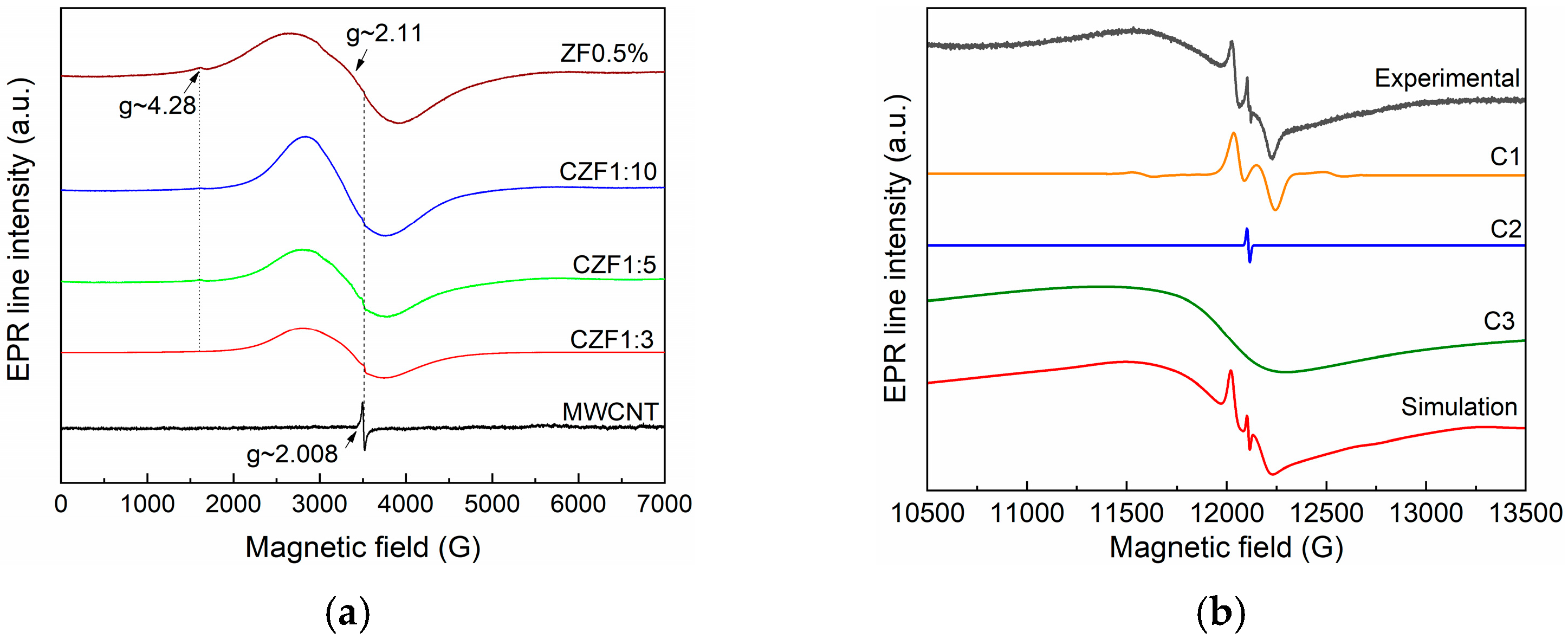
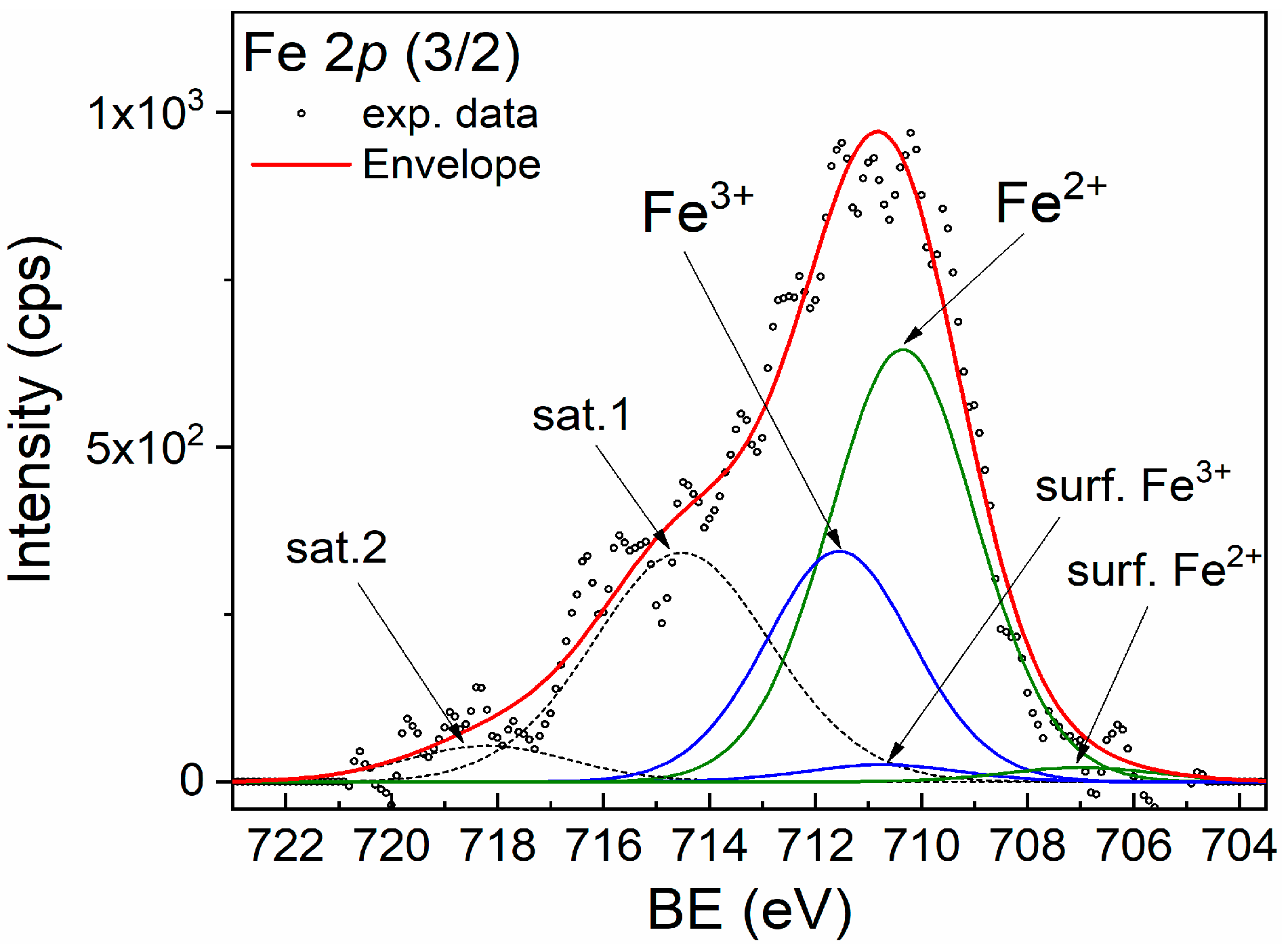

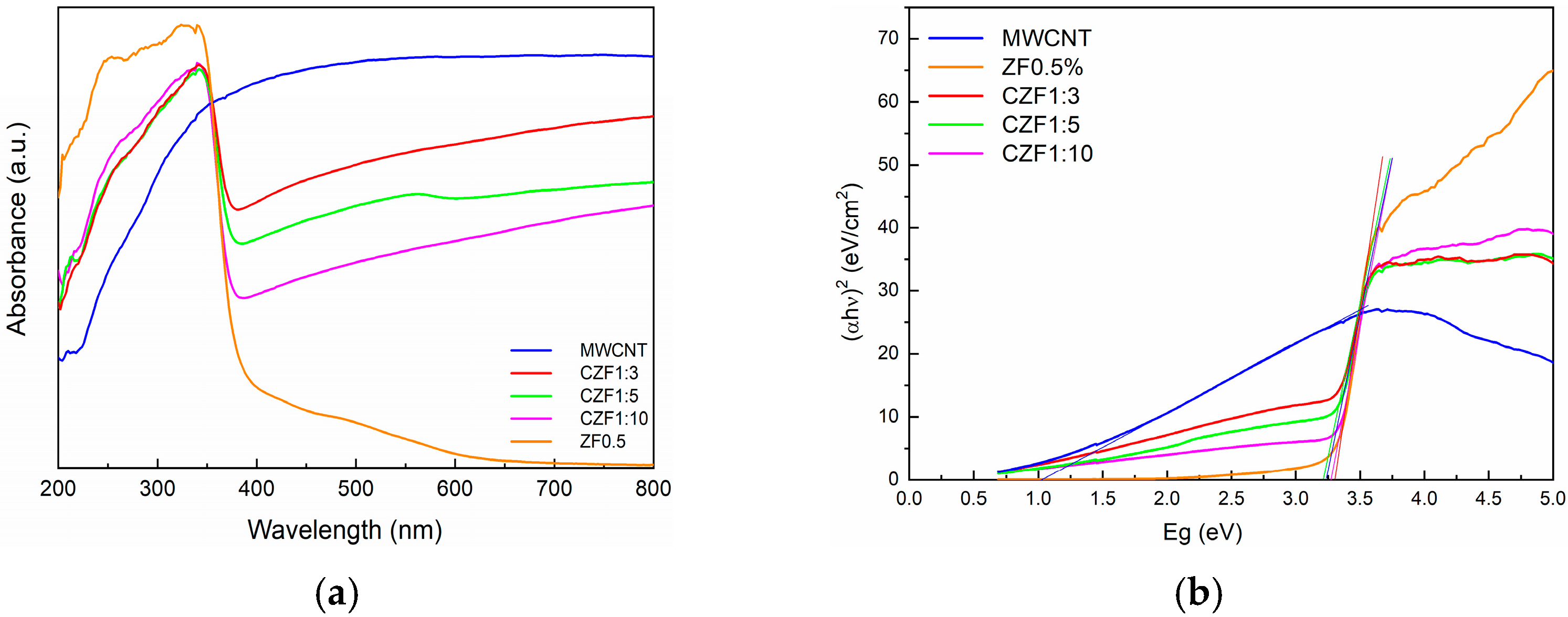


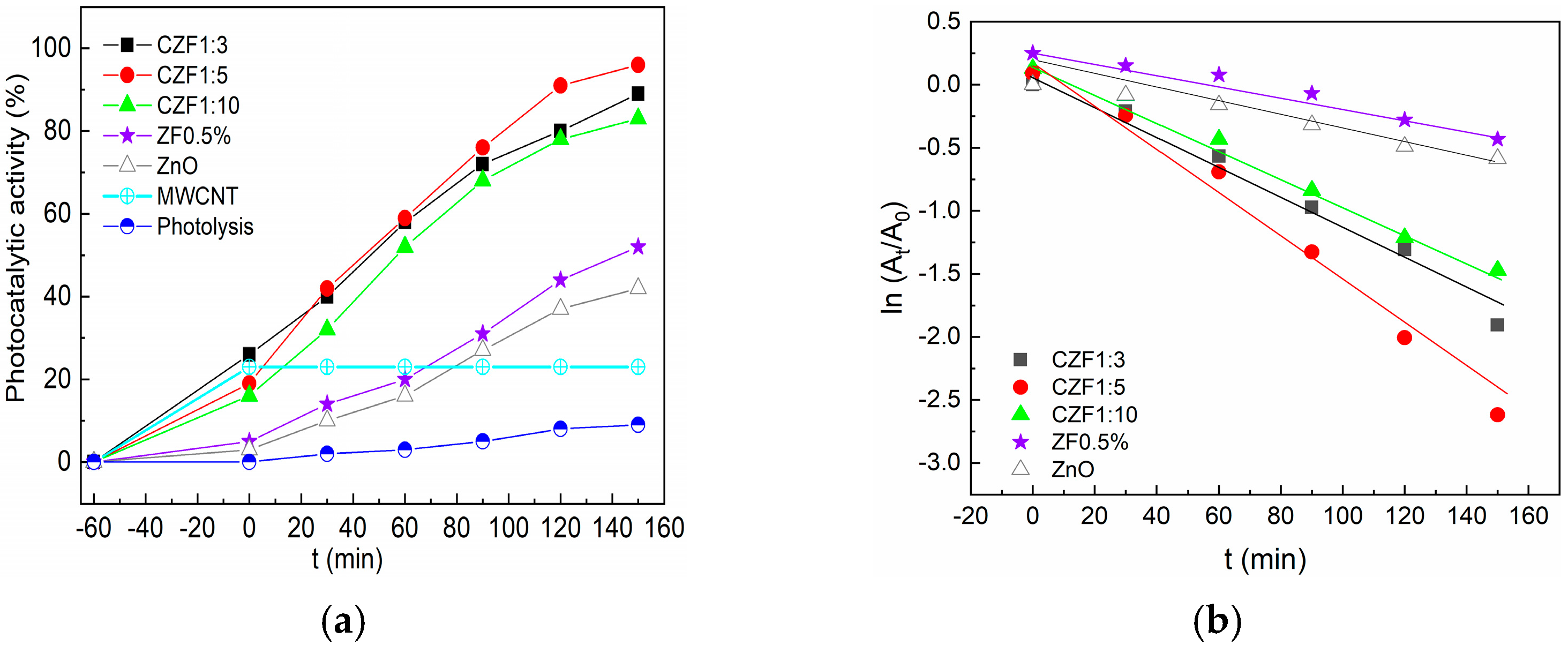
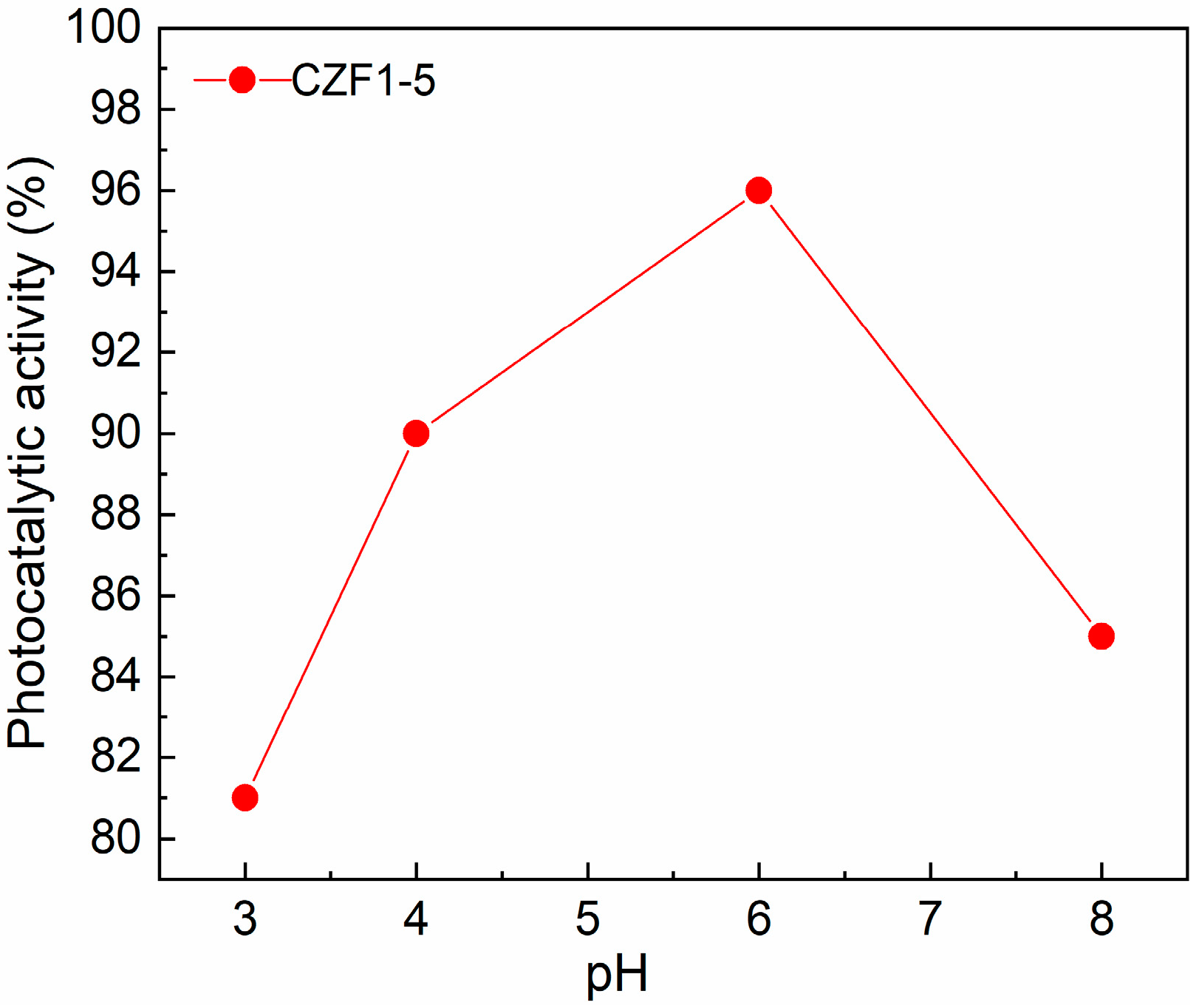
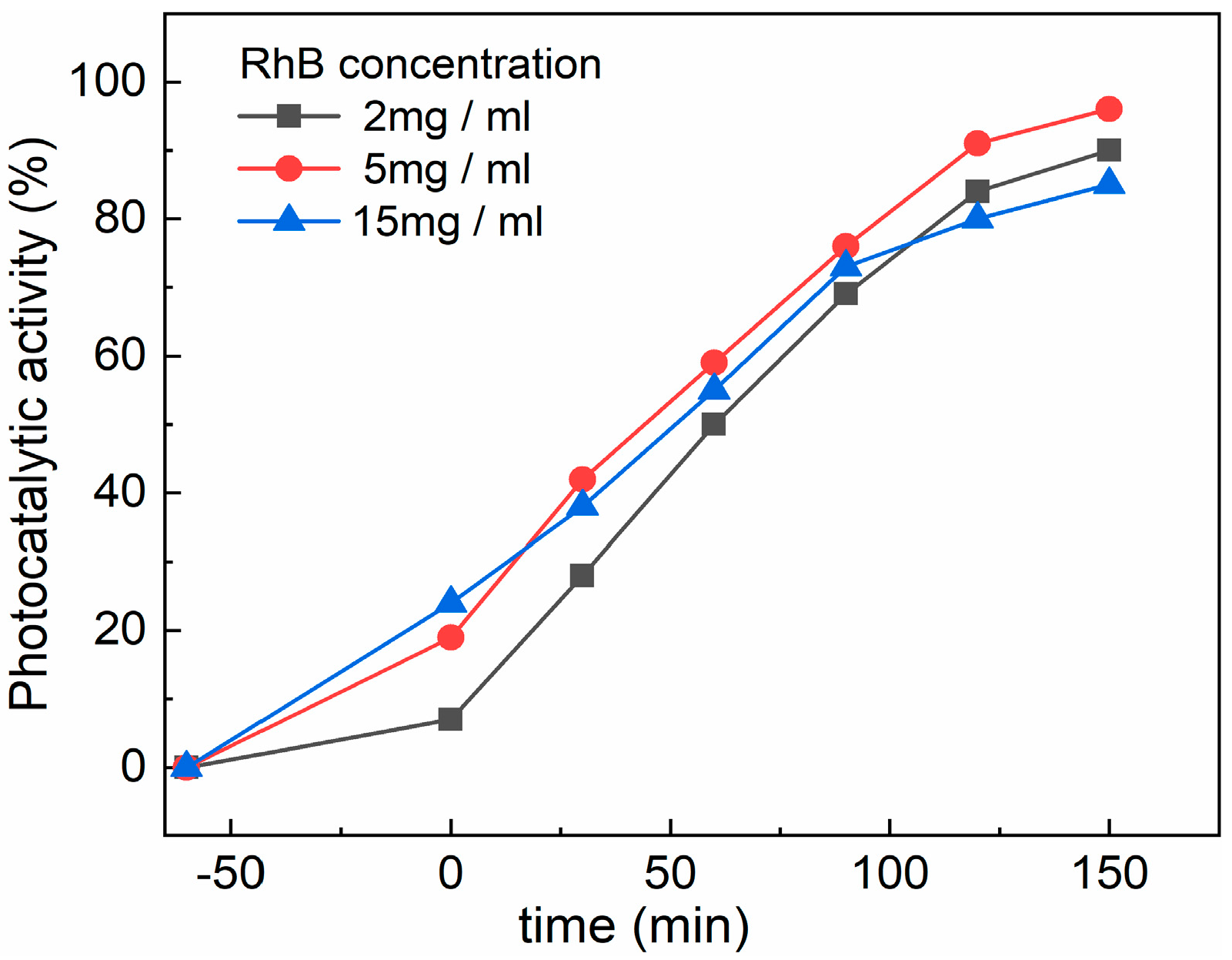

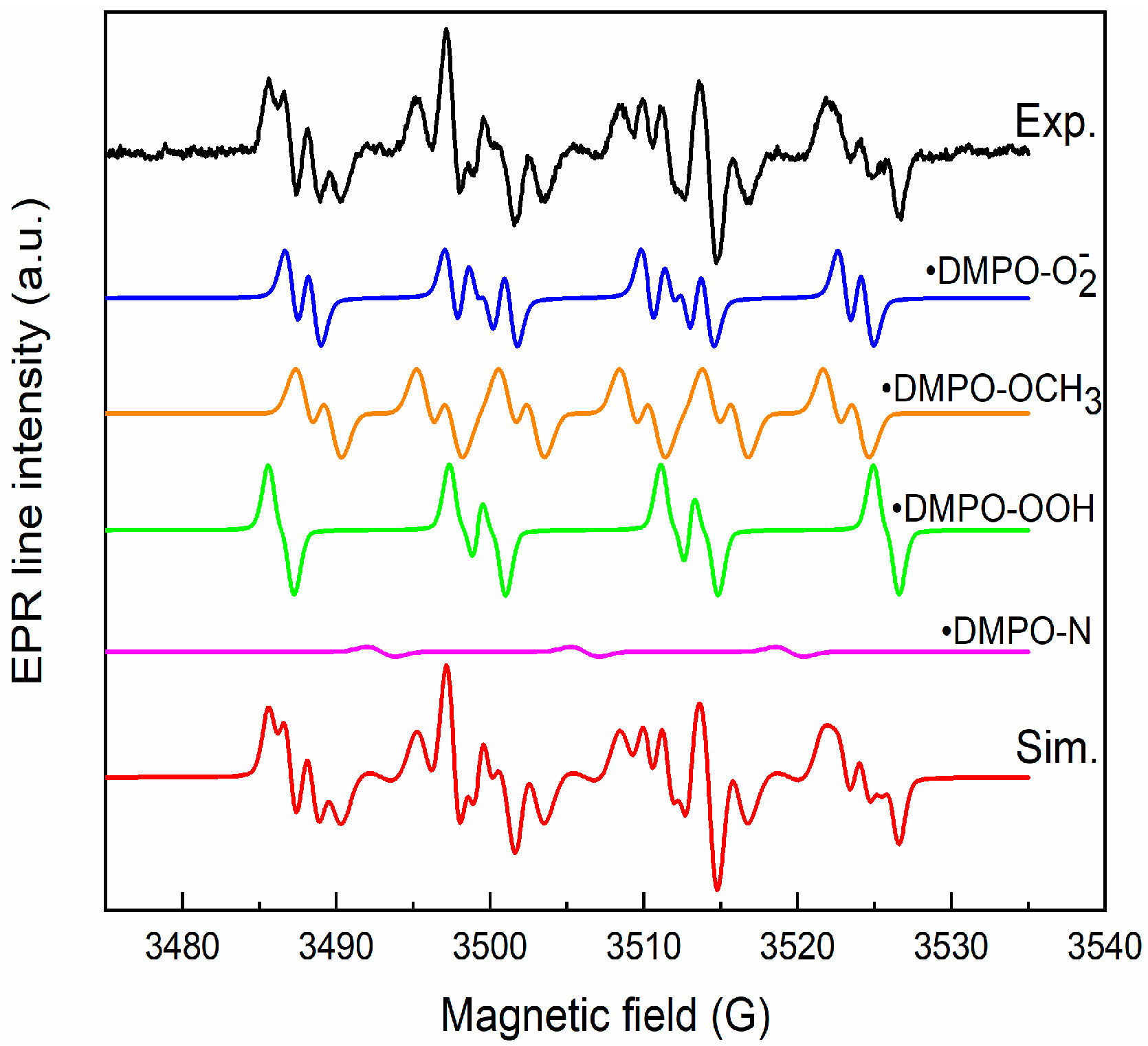
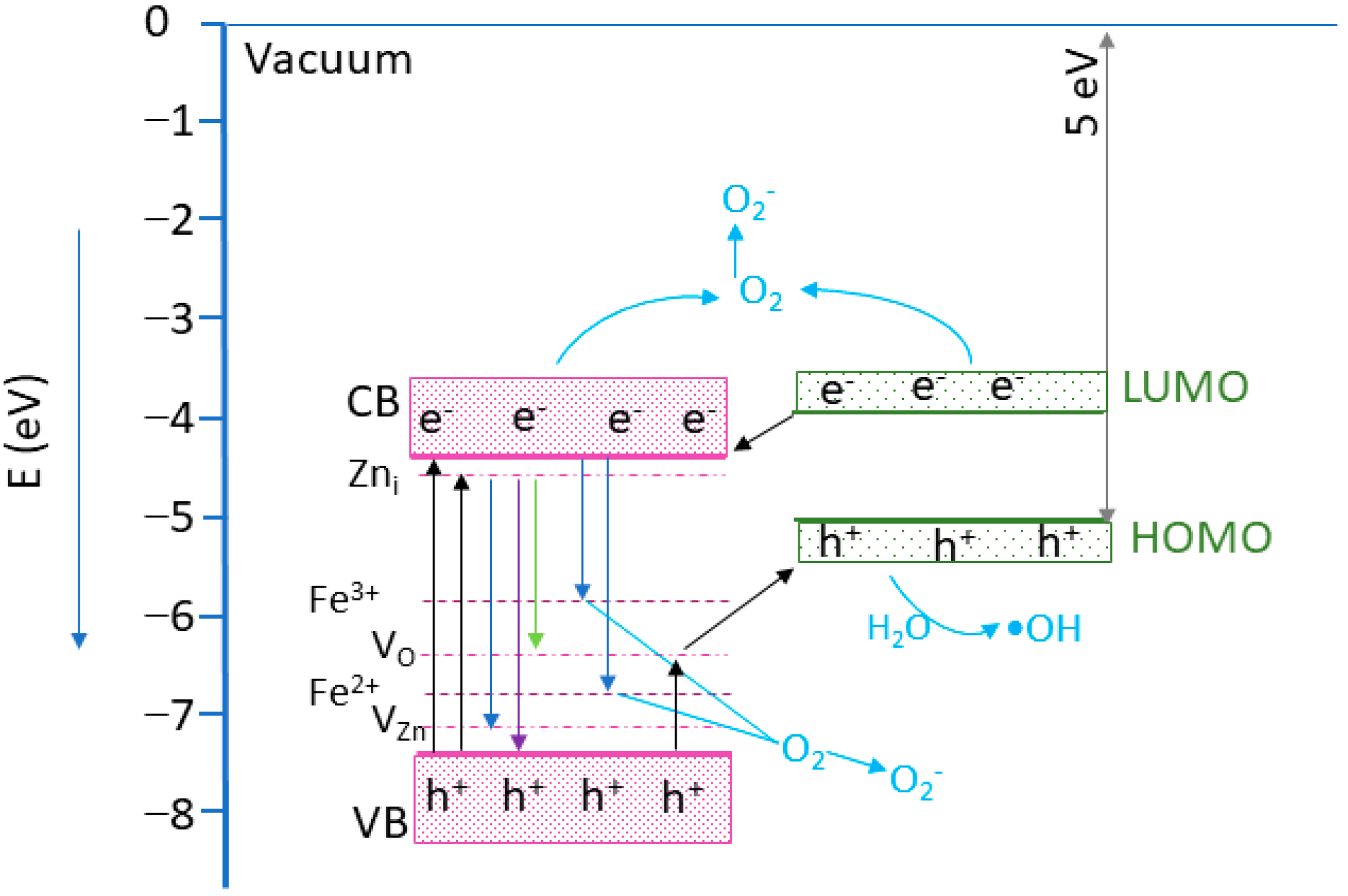
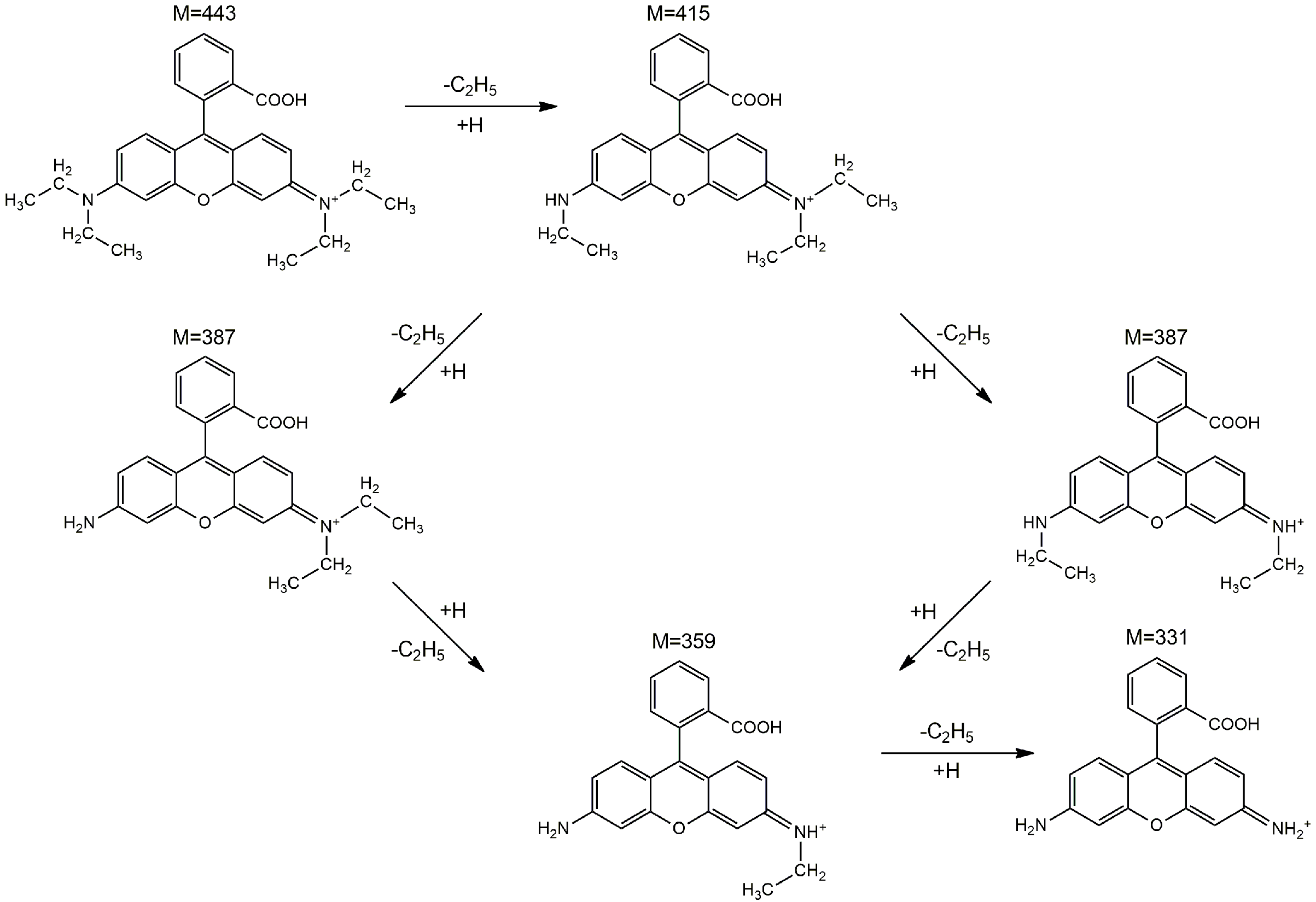
| Sample | a = b (Å) | c (Å) | V (Å3) | Dcryst (nm) | Rwp (%) | Rp(%) | Rexp(%) | χ2 |
|---|---|---|---|---|---|---|---|---|
| ZnO | 3.2472 | 5.2023 | 47.508 | 13.4 | 4.74 | 3.55 | 3.15 | 1.5 |
| ZF0.5% | 3.2480 | 5.2060 | 47.565 | 11.5 | 7.31 | 5.42 | 5.14 | 1.6 |
| CZF1:3 | 3.2478 | 5.2059 | 47.560 | 11.5 | 10.84 | 8.39 | 7.41 | 1.7 |
| CZF1:5 | 3.2479 | 5.2059 | 47.562 | 11.5 | 9.83 | 7.38 | 6.42 | 1.6 |
| CZF1:10 | 3.2479 | 5.2060 | 47.563 | 11.5 | 8.21 | 6.83 | 5.98 | 1.6 |
| Sample | A3.86 | A3.50 | A3.30 |
|---|---|---|---|
| CZF1:10 | 0.73 | 3.15 | 4.37 |
| CZF1:5 | 0.46 | 1.13 | 2.55 |
| CZF1:3 | 0.82 | 2.28 | 2.88 |
| Sample | A3.02 | A2.82 | A2.62 | A2.50 | A2.27 |
|---|---|---|---|---|---|
| CZF1:10 | 3.63 | - | 1.86 | 8.39 | |
| CZF1:5 | 2.56 | 1.94 | 1.18 | 1.58 | 6.56 |
| CZF1:3 | 0.40 | 0.20 | 1.32 | 1.66 |
| Sample | ki × 10−3 (min−1) | R2 |
|---|---|---|
| ZnO | 4.1 | 0.98 |
| ZF0.5% | 4.6 | 0.98 |
| CZF1:3 | 12.6 | 0.96 |
| CZF1:5 | 20.16 | 0.99 |
| CZF1:10 | 11.2 | 0.96 |
| Photocatalyst | Pollutant Type | Pollutant Concentr. | Light Irrad./Power Source or Illuminance | Irrad. Time (min) | Catalyst Concentr(mg/mL) | Removal Rate (%) | Ref |
|---|---|---|---|---|---|---|---|
| MWCNT-ZnO:Fe | RhB | 1 × 10−5 M | UV/30 W | 150 | 0.2 | 95 | This work |
| g-C3N4/ZnO/MWCNT | Alprazolam | 0.1 mmol/L | UV/125 W | 15 | 1.0 | 100 | [50] |
| ZnO-Ag/MWCNT | Phenol | 10 mg/l | UV/not specified | 240 | 1.0 | 81 | [51] |
| NiFe2O4/MWCNT | Methylene blue | 20 mg/l | UV/233 lux | 150 | 0.025 | 88 | [52] |
| Bi0.5Na0.5TiO3/MWCNT | RhB | 5 mg/L | UV/300 W | 40 | 1.0 | 100 | [53] |
Disclaimer/Publisher’s Note: The statements, opinions and data contained in all publications are solely those of the individual author(s) and contributor(s) and not of MDPI and/or the editor(s). MDPI and/or the editor(s) disclaim responsibility for any injury to people or property resulting from any ideas, methods, instructions or products referred to in the content. |
© 2023 by the authors. Licensee MDPI, Basel, Switzerland. This article is an open access article distributed under the terms and conditions of the Creative Commons Attribution (CC BY) license (https://creativecommons.org/licenses/by/4.0/).
Share and Cite
Popa, A.; Stefan, M.; Macavei, S.; Muresan, L.E.; Leostean, C.; Floare-Avram, C.V.; Toloman, D. Photoluminescence and Photocatalytic Properties of MWNTs Decorated with Fe-Doped ZnO Nanoparticles. Materials 2023, 16, 2858. https://doi.org/10.3390/ma16072858
Popa A, Stefan M, Macavei S, Muresan LE, Leostean C, Floare-Avram CV, Toloman D. Photoluminescence and Photocatalytic Properties of MWNTs Decorated with Fe-Doped ZnO Nanoparticles. Materials. 2023; 16(7):2858. https://doi.org/10.3390/ma16072858
Chicago/Turabian StylePopa, Adriana, Maria Stefan, Sergiu Macavei, Laura Elena Muresan, Cristian Leostean, Cornelia Veronica Floare-Avram, and Dana Toloman. 2023. "Photoluminescence and Photocatalytic Properties of MWNTs Decorated with Fe-Doped ZnO Nanoparticles" Materials 16, no. 7: 2858. https://doi.org/10.3390/ma16072858
APA StylePopa, A., Stefan, M., Macavei, S., Muresan, L. E., Leostean, C., Floare-Avram, C. V., & Toloman, D. (2023). Photoluminescence and Photocatalytic Properties of MWNTs Decorated with Fe-Doped ZnO Nanoparticles. Materials, 16(7), 2858. https://doi.org/10.3390/ma16072858






